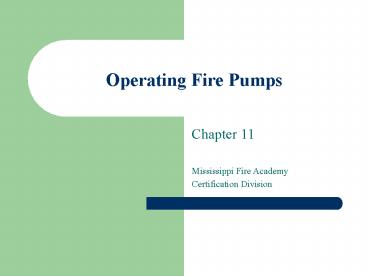Operating Fire Pumps - PowerPoint PPT Presentation
1 / 36
Title:
Operating Fire Pumps
Description:
Sprinkler & Standpipe Support. Driver/Operator provides adequate water and pressure. ... Supporting Standpipe Systems. Supply in same manner as sprinkler ... – PowerPoint PPT presentation
Number of Views:1660
Avg rating:3.0/5.0
Title: Operating Fire Pumps
1
Operating Fire Pumps
- Chapter 11
- Mississippi Fire Academy
- Certification Division
2
Three Sources of Water Supply
- Tank Water
- Pressurized source
- Static Source
3
Making the Pump Operationalbegins with
- Positioning the apparatus
- Setting the parking brake
- Wheels are chocked
4
Engaging PTO Front Mount PumpsPump Roll
- Come to a stop
- Place transmission in neutral
- Operate PTO
- Place transmission into proper gear
- Release brake and/or clutch
5
Engaging PTO Front Mount Pumps(Stationary Pump)
- Come to a full stop set parking brake
- Place transmission into neutral
- Operate PTO
- Place transmission into proper gear
- Check Owners Manual
6
Disengaging PTO and Front Mount Pumps
- Reduce engine speed to idle
- Disengage clutch or place transmission in
neutral - Operate PTO to disengage pump
7
Engaging Midship Pumps
- Stop vehicle, put transmission in neutral, set
parking brake - Engage power transfer device
- Place transmission into proper gear
- Check owners manual
- Check pump transfer light and speedometer
8
Disengaging Midship Pumps
- Reduce engine
- Place transmission in neutral
- Watch speedometer go to zero
- Operate pump shift lever
9
Auxiliary Engine Pumps
- Designed to be in gear when started
10
Operating from the Water Tank
- Most fires may be extinguished from this source.
11
Putting the Pump into Operations
- Safely exit
- Chock Wheels
- Opens tank-to-pump
- Place pump in parallel or series (two stage pump
only) - Open discharge slowly
- Increase engine speed
- Set relief valve
12
Transition to External Water Supply
- Usually involves a pressurized source such as a
hydrant or relay.
13
Making the Transition
- Position the apparatus
- Place transmission in neutral
- Operate shift lever to pump gear
- Put transmission into proper gear
- Exit the vehicle
14
Making the Transition(continued)
- Chock the wheels
- Open tank to pump
- Place pump to pressure or volume
- Open discharge slowly
- Increase RPM
15
Making the Transition (continued)
- Set relief valve
- Connect supply line
- Open hydrant Open intake valve
- Crack tank refill
16
Operating from a Pressurized Source
- Two sources
- 1. Hydrant
- 2. In Relay
17
Hydrant Operations
- Determine which hydrant is most appropriate
- Closet
- Safest
- Most water
18
Making a Forward Lay
- Drop line and proceed to the fire
- Make connections
19
Reverse Lay
- Used when the apparatus must stay at the source
- Requires 2½ or larger line
- Disadvantage-all equipment must be removed
20
Getting the Water Into the Pump
- Open bleeder valve to bleed air
- Open hydrant
- Close bleeder valve
- Open intake
- Take static reading
21
Getting the Water Into the Pump (continued)
- Close tank-to-pump valve slowly
- Open discharge
- Operate throttle
- Set relief valve
- Watch gauges
22
Putting the Pump in Service
- Avoid dry running
- Pull booster line
- Crack tank fill
- Open auxiliary cooler
23
Shutting Down the Hydrant
- Throttle down
- Disengage pressure governor
- Close discharges
- Place transmission in neutral
- Close hydrant
24
Operating from a Static Water Supply
- Pulling water is Impossible
- Atmospheric pressure is 14.7 at sea level
- Friction loss is dependant on
- Size of hose
- Distance
- Height of lift
- Maximum vacuum most pumps develop is 22 inches
25
Selecting a Drafting Site
- Dictated by
- Amount of water
- Type of water
- Accessibility of water
26
Amount of Water
- Most important factor
- Use strainer
27
Type of Water
- Non-potable Water is harmful
- Salt water corrodes
- Dirt or sand is bad stuff
28
Accessibility
- Lift and Friction loss factors to consider
- Pump capacity decreases with more lift
- The higher the lift, the less that can be pumped
29
Connecting to the Pump
- Position Apparatus
- Less than 20 ft of lift
- Stop short of draft sight
- Make connections
- Move pumper into position
30
Priming
- Engage pump
- Increase RPM
- Open discharge
- Operate changeover valve if applicable
- Increase rpm to proper setting
- Set relief valve or governor
31
Operating the Pump from Draft
- Most demanding
- Overheating may occur
- Problems to look for
- Air leaks
- Whirlpools
- Defective pump packing
- Blocked strainer
32
Shutting Down the Operation
- Decrease engine speed
- Take pump out of gear and allow to drain
- Operate primer to lubricate
33
Sprinkler Standpipe Support
- Driver/Operator provides adequate water and
pressure.
34
Supporting Automatic Sprinkler Systems
- Consider pre-incident plans
- Consists of 2 x 2½ or 1 large diameter intake
- Use at least 2 x 2½ inch or 1 LDH to supply
- Consult SOPs
- Rule of thumb
- 1,000 gpm pumper for every 50 heads
- Pump in volume on Multi-stage pumps
35
Supporting Standpipe Systems
- Supply in same manner as sprinkler systems
- Discharge depends
- Friction loss (25psi)
- Friction loss in supply hose
- Friction loss in attack lines
- Max 200 psi
- Elevation
36
Thanks To
- Kosciusko Fire Department
- Flowood Fire Department































